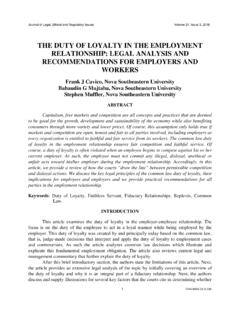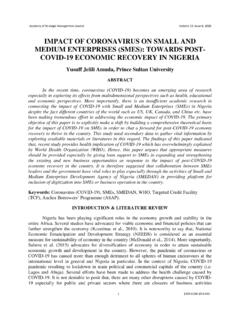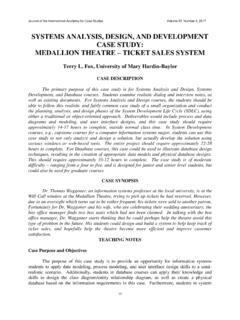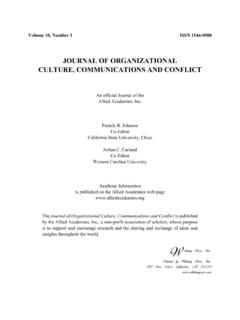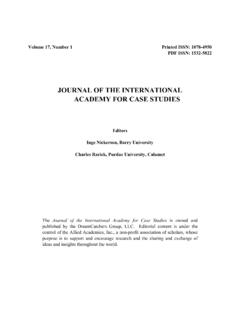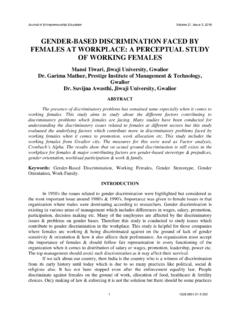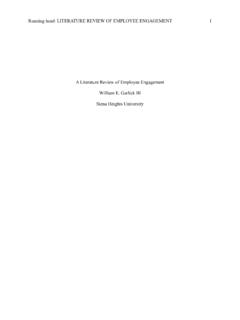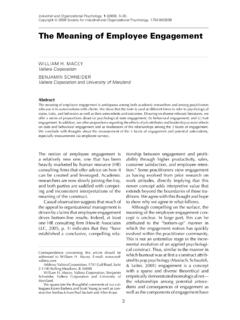Transcription of Effect of Reward System on Employee Performance among ...
1 Academy of Strategic Management Journal Volume 18, Issue 3, 2019. Effect OF Reward System ON Employee . Performance among SELECTED. MANUFACTURING FIRMS IN THE LITORAL REGION. OF CAMEROON. Walters T. Ngwa, University of Nigeria Bamidele S. Adeleke, Ladoke Akintola University of Technology Emmanuel K. Agbaeze, University of Nigeria Nwanneka C. Ghasi, University of Nigeria Benedict O. Imhanrenialena, University of Nigeria ABSTRACT. This study investigates the Effect of Reward System on Employee Performance in selected manufacturing firms in the Littoral Region of Cameroon. Specifically, the study assesses the degree to which profit sharing affects Employee commitment in manufacturing firm; ascertains the Effect of flat-rate systems on Employee work values in manufacturing firms; and appraises the influence of collective bargaining Reward systems on Employee cohesiveness in manufacturing firms.
2 This research work is a survey which makes use of a sample of 538 employees drawn from a population of 5146 employees of ten selected manufacturing firms within the Cameroon Littoral Region. The sample was selected by the use of the Cochran's formula for finite population sample at a 95% confidence level. The major source of data used for the study was primary data and the instrument used for data collection was questionnaire. The findings revealed that, profit sharing had a significantly positive Effect on Employee commitment in manufacturing firms; flat rate systems had a significantly negative Effect on Employee work values in manufacturing firms; and collective bargaining Reward systems had a significantly positive impact on Employee cohesiveness in manufacturing firms.
3 The study concluded that there is a positive link between Reward systems and Employee Performance . This link creates an opportunity for employers to use Reward System as a motivating factor to fine-tune Employee behaviour towards efficiency and effectiveness. Based on the findings, it was recommended amongst others that Reward systems for manufacturing firms should be designed such that employees are entitled to percentages of profit earned by the firm as a means of promoting productivity and group cohesiveness amongst employees. The study further advised that employees in manufacturing firms should not be paid fixed salaries as it could result in a high rate of tardiness and reluctance of employees within a group to put in anything more than the Performance of an average performer in the group.
4 Keywords: Reward System , Work Values, Employees Commitment, Employees Cohesiveness. INTRODUCTION. In this present world of globalization where business has gone beyond national boundaries and employees are protected by international laws and engagement, Reward systems are fast becoming a competitive tool to many firms. The advent of globalization has brought 1 1939-6104-18-3-382. Academy of Strategic Management Journal Volume 18, Issue 3, 2019. about greater pressure on business management to be proactive, creative and innovative in order to survive the turbulent business environment that now transcends national boundaries (Ezigbo, 2011). Business management has gone beyond routine processes of mass production with the aim of benefiting from economy of scale.
5 Consumer needs, taste and fashion not only vary from one society to the other but constantly change with time and season. Consumers are in constant demand for product differentiation and new product features. Different consumer groups based on health age and need emerge on a day to day basis. This calls for a better management of resources and a prompt response to consumer needs as a key determinant of survival (Hill, 2004). Maximizing the Performance of organizations is the main issue for an organization (Candy, 1997; Milkovich et al., 2011). Plants, machinery, and equipment cannot generate the desired output. They have a relatively fixed production capacity. It is only the human resource whose output is subject to a number of motivating factors.
6 The success of every organization depends not only on the quality of human resources available to the organization but also on the ability to trigger the optimum output from an Employee (Pratheepkanth, 2011). Ahindo (2008). opines that success in today's increasingly competitive environment is to a greater extent a function of effective and efficient management of human resources available to the business organization. This calls for the development of a work force that is motivated to yield the highest possible Performance and productivity for the firm towards achieving its organizational goals and objectives. Having the best strategy in place and appropriate organizational architecture is not a guarantee that an organization will be effective.
7 This can only be complimented when organizational members are motivated to perform at a high level. While machines and robots can be programmed and controlled to consistently produce the same amount of output, upgrade to perform better or replaced if not functioning properly, humans cannot be programmed and controlled. Their level of productivity is subject to their level of motivation (Bayon, 2013). Employees are bound to the organization by terms of a contract, labour union laws, state and human right regulations. As such employees cannot be replaced like machined or compelled to deliver under adverse conditions. However, when an organization undertakes to satisfy the needs of employees, it triggers a desire in the Employee to return this favour with hard work and commitment.
8 Thus, identifying the needs of the employees and answering it is the most basic approach of every organization to earn their commitment to organizational goals and objectives (Chughtai, 2008). Generally, individuals are motivated to work by the needs they have which require satisfaction. Such individuals are committed to jobs they perceive to have a possibility of satisfying their needs through the Reward they will receive for the work done. The type of motivation depends greatly on the nature of the Reward . Remuneration is, therefore, one of the factors that have the ability to improve the Performance of individuals and organizations by increasing productivity, quality of Performance and encouraging positive work attitudes from workers to be in line with organization's objectives (Bayon, 2013).
9 Intrinsically motivated individuals will be committed to their work only when they find out that their job contains task that is intrinsically rewarding (Ajila, 1997). In the same light, extrinsically motivated persons will be committed to the extent that they can gain or receive external rewards for their job. In a nut shell, you can only get what you Reward . Good remuneration, therefore, is expected to contain elements that Reward both intrinsically and extrinsically to trigger both extrinsic and intrinsic motivation from the Employee . With a well-motivated workforce, Employee 2 1939-6104-18-3-382. Academy of Strategic Management Journal Volume 18, Issue 3, 2019. Performance can be manifested on organizational effectiveness, which allows individuals to focus on the development of their work, in terms of behaviour, knowledge, ethics, skills, and effectiveness (Pratheepkanth, 2011).
10 The Performance of every Employee is a major concern to the human resource department. In spite of the qualification and longevity of service of an Employee , workers are sometimes reluctant to put in their best at their job site. Some who show a high level of Performance at the start of their career start diminishing at the time they are expected to use their experience and perform even at a higher level. Many work only within the confines of their job specification and are not interested in putting in any additional effort in driving the organizational goals. This takes away creativity from the work place, limits invention and improvement and places such a firm at a competitive disadvantage in the adverse business world that is constantly shifting to meet consumer needs and expectations.
